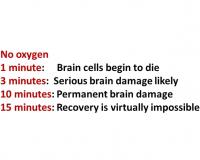Overview
A few minutes of oxygen deprivation can lead to lifelong brain damage and brain death is inevitable unless blood oxygen levels are restored to normal. Emergency oxygen delivery systems are available for first aid use and can save lives by providing short-term oxygenation until the patient arrives at a medical facility. However, these delivery systems are not useful in certain emergency medical events such as airway obstruction from aspirated foreign bodies, cardiac arrest, anaphylaxis, windpipe damage and/or fluids in the mouth. Additionally, during the standard “hands only” CPR, patient survival can be limited by lack of oxygen since this is not currently part of basic life support protocol. At the hospital, intubation and mechanical ventilation is done to help patients breathe when they cannot move enough air in and out of their lungs on their own. When physicians are faced with a “cannot intubate and cannot ventilate” situation, they perform an emergency oxygenation procedure, wherein a hole is cut through the cricothyroid membrane and an oxygenation catheter is inserted into the airway for oxygen supply to the lungs. This emergency airway puncture procedure is called cricothyroidotomy and it is one of the several emergency airway management techniques that offer lifesaving short-term oxygenationbut it can be performed safely only in the clinic. Additionally, the devices and methods currently used for cricothyroidotomy call for a skilled/experienced professional who has received extensive prior training to perform the emergency procedure.
UMB investigators propose to bring to market a patent pending first aid emergency oxygenation device that can deliver oxygen (and drugs) directly to the lungs, for up to one hour, thus limiting the many dangerous consequences of oxygen deprivation to the brain. It consists of a skin puncture/delivery component and a ventilator catheter for oxygen delivery to the lungs. Unlike conventional methods, this device does not require the use of a scalpel or a guide wire to insert a catheter into the trachea, and hence is technically straightforward and quick to deploy. With some minimal basic training and by following the kit instructions, individuals with a Basic Life Support (BLS) certification will be able to deploy the device effortlessly. The device will supply oxygen to the hypoxic individual until an intubation can be done by skilled personnel. A modified version enables operation in the dark for use on a battlefield.
Photos
Applications
This emergency kit can potentially keep patients alive by providing short-term emergency oxygenation in any of the following situations (before the patient arrives at a medical facility):
Out-of-hospital cardiac arrest (~300,000 sudden cardiac arrests in the US annually); Currently, first aid and rescue workers perform CPR, however, the mortality rate is still very high (approximately 25% for respiratoryarrest in adults, and almost 50% for respiratory arrest for children). Hence, at some time during prolonged CPR, supplementary oxygen with assisted ventilation is necessary.
Anaphylaxis (nearly 0.05–2% of world's population has anaphylaxis at some point in their lives); Patients with severe life-threatening asthma requiring urgentand aggressive treatment - simultaneous administration of oxygen, bronchodilators, and steroids
Wounded soldiers in the battlefield
Mass casualty triage
Patients with acute stroke are at risk for respiratory compromisefrom aspiration, upper airway obstruction, and hypoventilation. The timely supply of oxygen will reduce hypoxemia due to poor perfusion and minimize ischemicbrain injury.
Advantages
· Oxygen is delivered to the lungs directly and for up to 1 hour
· Maintenance of blood oxygen levels to prevent brain injury or death
· Continuous flow of oxygen without manual ventilation
· A portable device
· Lower skill level requirement, minimal training
· Emergency use in the dark
Stage of Development
The investigators are currently doing a proof of concept laboratory study in a non-breathing swine model.
- MEW
Contact Info
Office of Technology Transfer
620 W Lexington St., 4th Floor
Baltimore, MD 21201
Email: [email protected]
Phone: (410) 706-2380
